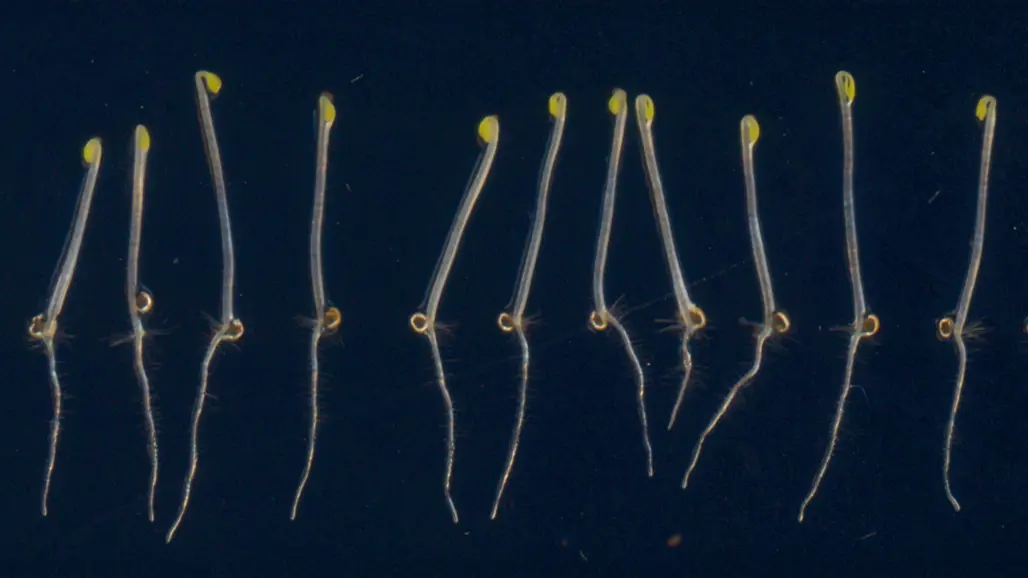
The protein that helps seedlings straighten
Seedlings bend their tip as they grow through soil, then straighten when they reach light. Scientists from Umeå have, after years of challenging research, identified a protein that promotes this straightening by regulating cell growth through the plant hormone auxin.
It is a tough beginning for a young plant. To survive, the seedling must reach the light and begin photosynthesis before exhausting the energy stored in the seed. To protect its fragile tip, which contains the young and sensitive leaves, while emerging from the soil, the seedling bends its shoot tip downward into a hook-like shape. However, once it breaks through the surface, this “apical hook” is no longer needed. The seedling then straightens and lifts its tip, guiding its leaves towards the light.
“The opening of the apical hook is a crucial and dynamic early step in the development of a young plant and is still not very well-understood,” says Stéphanie Robert, professor at Swedish University of Agricultural Sciences and group leader at Umeå Plant Science Centre. “We were curious to learn more about how the seedling can control the accuracy and timing of this straightening - what signals are involved and whether any previously unknown components play a role.”
The multidisciplinary team led by Stéphanie Robert combined experts from biology, chemistry, biochemistry and computational biology. Together, they took a rather unconventional approach to studying plant biology. They screened thousands of chemicals to observe their effects on apical hook development and identified one particular compound that slowed down the hook’s opening. Using a technique to identify potential interactors of this chemical, they discovered that it binds to the protein RACK1A.
A previously unknown role for RACK1A in seedling growth
“Thanks to these methods we found that RACK1A is involved in apical hook opening. The protein was known before, but this function was completely new”, explains Siamsa Doyle, staff scientist in Stéphanie Robert’s research group and one of the three co-first authors of the study. “We showed that this protein promotes the opening of the hook by differentially adjusting cell growth on either side of it through the action of the plant hormone auxin.”
Auxin has long been recognised as a key regulator of differential cell growth, where cells in one part of a tissue grow faster than those in other parts, resulting in shaping or bending of organs. Unlike animals, plants cannot move to a more favourable location. Instead, they adjust their growth to orient organs such as leaves or flowers towards sunlight or away from excessive heat, for example. This ability to shape and move their organs during development and in response to environmental challenges is driven by differential growth.
In the emerging seedling, auxin accumulates on one side of the shoot tip, which suppresses cell growth there, while cells on the opposite side grow more quickly. This imbalance creates the apical hook, which remains as long as the auxin accumulation is maintained. The researchers have now shown that RACK1A suppresses this auxin accumulation, allowing the previously inhibited cells to catch up in growth, resulting in the seedling straightening up.
The apical hook – a powerful model to understand plant growth
“The apical hook is an excellent model for studying differential growth,” says Stéphanie Robert. “It is a simple structure in which the growth, shaping and coordination of cells and tissues can be studied. Differential growth is absolutely crucial for plants to develop and thrive, and we still have a lot to learn about this fascinating and important process.”
The project faced numerous technical challenges and several postdoctoral researchers involved in the project moved on to other positions before it was completed. The breakthrough came only in the final stages. Now, the team plans to investigate auxin’s role further, focusing on its distribution within cells. They also aim to explore other signals involved in apical hook opening, as well as its formation, to gain a better understanding of how this process, and more broadly differential growth, is regulated.
“This project turned out to be a very long and difficult journey involving many people,” says Siamsa Doyle. “We - especially my fellow first authors, Qian Ma and Sijia Liu, both former postdocs in our group, and I - are delighted that we were finally able to reach our goal. We are very proud of our interesting findings but also relieved to be able to move on!”
About the article
Qian Ma, Sijia Liu, Siamsa M. Doyle, Sara Raggi, Barbora Pařízková, Deepak Kumar Barange, Hemamshu Ratnakaram, Edward G. Wilkinson, Isidro Crespo Garcia, Joakim Bygdell, Gunnar Wingsle, Dirk Roeland Boer, Lucia C. Strader, Fredrik Almqvist, Ondřej Novák & Stéphanie Robert. RACK1A positively regulates opening of the apical hook in Arabidopsis thaliana via suppression of its auxin response gradient. Proceedings of the National Academy of Sciences (PNAS) 122 (30), e2407224122 (2025).
Contact
-
Person
-
PersonStephanie RobertDepartment of Forest Genetics and Plant Physiology